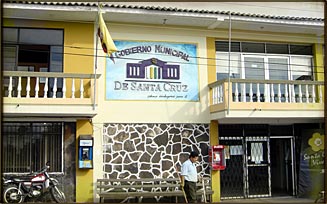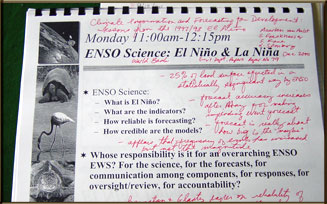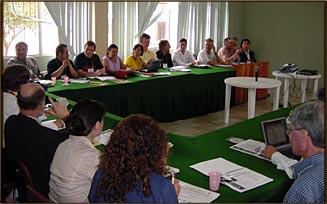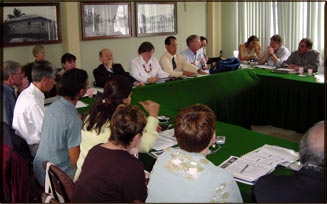
|

September
13, 2004
The name of this workshop is “El Niño Early Warning
for Sustainable Development in Pacific Rim Countries and Islands.”
As Mickey points out in the first formal day of the meeting,
each word by itself could be the focus of an entire workshop.
Indeed, in gatherings of this nature a lot of time is spent
clarifying language, and science conferences can often get
stuck on definitions. A good part of the first day is spent
attempting to come to some agreement on several terms in the
title, including sustainable development (more below), El
Niño (is it warm water or the entire pattern of climate
shifts caused by the changing water temperatures?); early
(is two months enough advance warning? What about countries
like Australia and India that get no warning?); and Pacific
Rim (does it only include the countries on the edge of the
Pacific, or can the term also include islands in the middle?).
We also batted around other terms that are included in the
meeting agenda such as knowledge, “hot spots,”
and weak (as in, “There is currently a weak El Niño
developing in the mid Pacific,” an announcement recently
made by NOAA, the National Oceanic and Atmospheric Administration).
We’re now housed in a meeting room at the civic center
after Jose Luis negotiated with the mayor of Puerto Ayota
for the space. To help with the discussions, Mickey and his
assistant DJan have prepared “view books,” which
are essentially bound notebooks with discussion bullet points
for each session and inspiring quotes and images throughout.
It’s a handy place to jot notes and ideas and most of
the participants do just that.
What Is Sustainable Development?
The discussions here are surprisingly philosophical for a
science workshop, and often touch on the meaning of environmental
justice, climate affairs, vulnerability, and resilience. Language
is constantly evolving and words are produced by social negotiation.
The fact that language can be ambiguous is both good and bad,
says participant Dale Jamieson, a philosopher and environmental
scientist at New York University. Good, because it gets people
to the table to work things out together, and bad, because
no one really knows what they’re talking about. In this
meeting, it makes for some lively discussion and we end up
discussing sustainable development for a good hour.
Sustainable development is a relatively new buzzword for balancing
the needs of humankind against the needs of ecosystems, but
its meaning shifts depending on where you put the emphasis.
Those who are focused on economics like to put development
first, but the sustainable folks would just as soon drop development
altogether, and have started to refer to the concept as sustainability.
Holger Meinke, who works with farmers in Australia, offers
the term "triple bottom line," which refers to the
negotiated trade off between economic, social, and environmental
needs. The understanding is that sometimes policies benefit
one of the factors more than the others.
What’s Hot and What’s Not?
Another loaded term is “hot spots,” which refers
to areas in the world that are affected by El Niño’s
shifting climate patterns.
The
map here
shows some of the areas socked by El Niño,
including Australia with droughts and Southern California
with heavy winter rains. As several people point out, the
problem with the map is that it’s too simplistic and
cartoon-like. You’re either in or you’re out (“sorry
India”), and there are no areas of gray.
The naming of a hot spot can also have political and economic
repercussions. When the media first picked up on El Niño,
the term was often associated with dramatic headlines about
deluges and droughts. That means that when an El Niño is declared,
some Pacific Islands could lose their valuable tourist trade
for a season. In the workshop, there was some discussion of
using other language to describe these climate anomalies,
but Mickey wasn’t ready to give up on the term. He said
“hot spots” was still better than “ENSO-specific
geography.”
|




